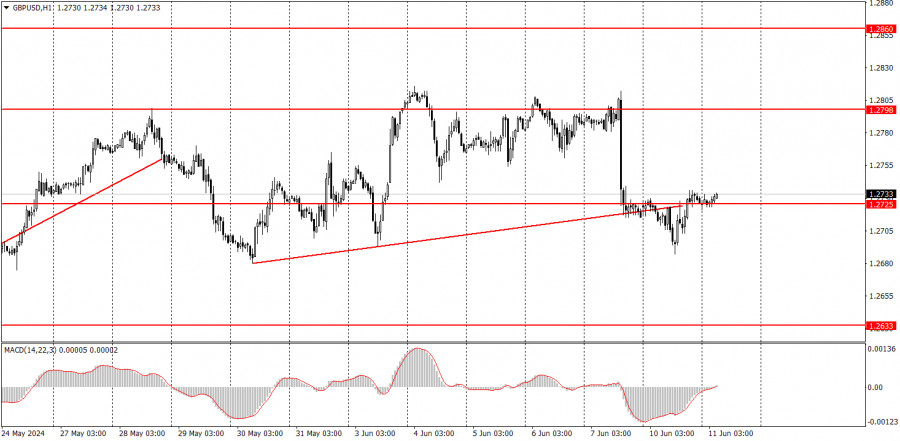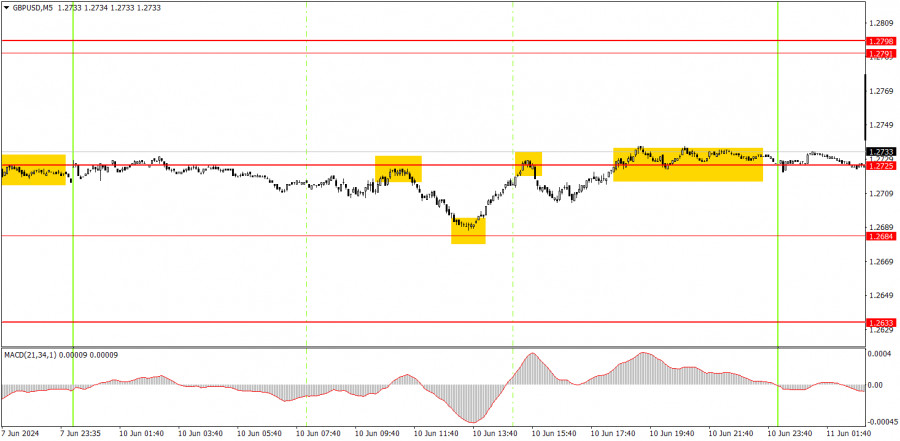

The GBP/USD pair failed to continue the downward movement. There was a weak attempt, but it ended very quickly. This is not visible on the hourly timeframe, but on higher timeframes, we can see a flat trend that started around the last week of May. In general, the pound has been trading between the levels of 1.2684 and 1.2798 for three weeks. The third ascending trend line was broken, and for the third consecutive time, we don't see any trend reversal or any emerging downward trend. The British currency continues to amaze with its resilience.
Yesterday, there were no reports or significant events published in either the UK or the US. As a result, volatility was low. At this time, the pound can easily head upwards to the level of 1.2798, which is essentially the upper boundary of the sideways channel. Once again, the pair is unable to start even a minor bearish correction.
GBP/USD on 5M chart
Several trading signals were formed on the 5-minute timeframe, like bounces from the levels of 1.2684 and 1.2725. Since the distance between these levels was 39 pips, the potential profit for each trade was no more than 15-20 pips. However, this is better than nothing. The situation could have been much worse on a "boring Monday".
Trading tips on Tuesday:On the hourly chart, the GBP/USD pair has great prospects for forming a downward trend, but the bullish correction remains intact. The market has finally considered the strong US data, but this could well be a one-off case. As we can see, the pound did not continue to fall on Monday despite breaking the trend line.
For Tuesday, we would advise you to expect the pound to rise further, as there has been another bounce from the area of 1.2684-1.2693. The flat trend remains intact, so after testing one boundary, it may move towards the other.
The key levels on the 5M chart are 1.2457, 1.2502, 1.2541-1.2547, 1.2605-1.2633, 1.2684, 1.2725, 1.2791-1.2798, 1.2848-1.2860, 1.2913, 1.2980. Today, the UK will release reports on the unemployment rate, unemployment claims, and wages. All three reports, which will be published simultaneously, could affect market sentiment.
Basic trading rules:1) Signal strength is determined by the time taken for its formation (either a bounce or level breach). A shorter formation time indicates a stronger signal.
2) If two or more trades around a certain level are initiated based on false signals, subsequent signals from that level should be disregarded.
3) In a flat market, any currency pair can produce multiple false signals or none at all. In any case, the flat trend is not the best condition for trading.
4) Trading activities are confined between the onset of the European session and mid-way through the U.S. session, after which all open trades should be manually closed.
5) On the 30-minute timeframe, trades based on MACD signals are only advisable amidst substantial volatility and an established trend, confirmed either by a trendline or trend channel.
6) If two levels lie closely together (ranging from 5 to 15 pips apart), they should be considered as a support or resistance zone.
How to read charts:Support and Resistance price levels can serve as targets when buying or selling. You can place Take Profit levels near them.
Red lines represent channels or trend lines, depicting the current market trend and indicating the preferable trading direction.
The MACD(14,22,3) indicator, encompassing both the histogram and signal line, acts as an auxiliary tool and can also be used as a signal source.
Significant speeches and reports (always noted in the news calendar) can profoundly influence the price dynamics. Hence, trading during their release calls for heightened caution. It may be reasonable to exit the market to prevent abrupt price reversals against the prevailing trend.
Beginners should always remember that not every trade will yield profit. Establishing a clear strategy coupled with sound money management is the cornerstone of sustained trading success.